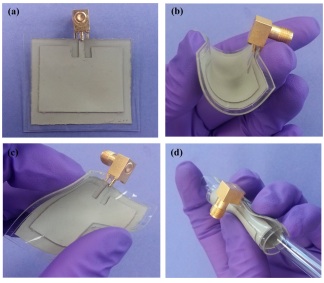
Correction: An earlier version of this story implied that MC10's electronics were merely flexible and not stretchable. Both Zhu's electronics and MC10's are both flexible and stretchable.
Dr. Yong Zhu and his research team at North Carolina State University, who earlier this year demonstrated flexible, stretchable sensors that could measure strain, pressure, human touch and bioelectronic signals, has now demonstrated a stretchable antenna using the same materials and technology.
"It's in the general context of remote health monitoring," Zhu told MobiHealthNews. "Remote health monitoring is a paradigm shift in health informatics. A lot of wearable sensors and electronics have been developed in recent years, so clearly there's a need to develop these wearable antennas to transmit the signals. That's the motivation. You get all the sensors, naturally you need the antenna."
Like the sensors his team developed, the antennae are built from silver nanowires. Although the end result is similar, Zhu's manufacturing process is significantly different from the technology developed at the University of Illinois at Urbana-Champaign for Cambridge-based stretchable, flexible sensor company MC10, which uses microfabricated stamped silicon for its BioStamp technology. Zhu says his technology is potentially more stretchable then MC10's technology, as well as easier to manufacture and, potentially, scale.
Zhu stressed the distinction between flexible and stretchable sensors and told MobiHealthNews that stretchable sensors in general presented a greater design challenge.
"In order to have really a conformal system you would need something not only flexible, but somewhat stretchable," he said. "A system that can be largely deformed. Curved, twisted or even stretched. Stretchable is more challenging than flexible. It has to be reversible and repeatable."
Antennae present a unique challenge because stretching and bending an antenna actually changes the frequency it transmits at, as anyone who remembers adjusting a "rabbit ear" television set can attest. Zhu says the technology has the capacity to turn this bug into a feature: the variability is small enough that most receivers will be able to pick up the signal even if the antenna is stretched, but with a sensitive enough receiver, the antenna could actually function as a sensor in its own right, as the change in frequency would signal how the antenna is being manipulated.
Zhu's antenna, as tested in a paper in Applied Materials and Interfaces, is about 30 mm square. The team tested both a single antenna and a two-antennae array, and found that the single antenna transmitted at 3 GHz and the array at 6 GHz. The range of the antennae at that frequency would depend on its power source, a piece of the puzzle that the NCSU team has not yet worked out for a wearable device.
The next paper, Zhu says, will demonstrate how the silver nanowire sensors and silver nanowire antennae can be integrated in a single prototype. After that, commercialization of the device is a possibility.


















